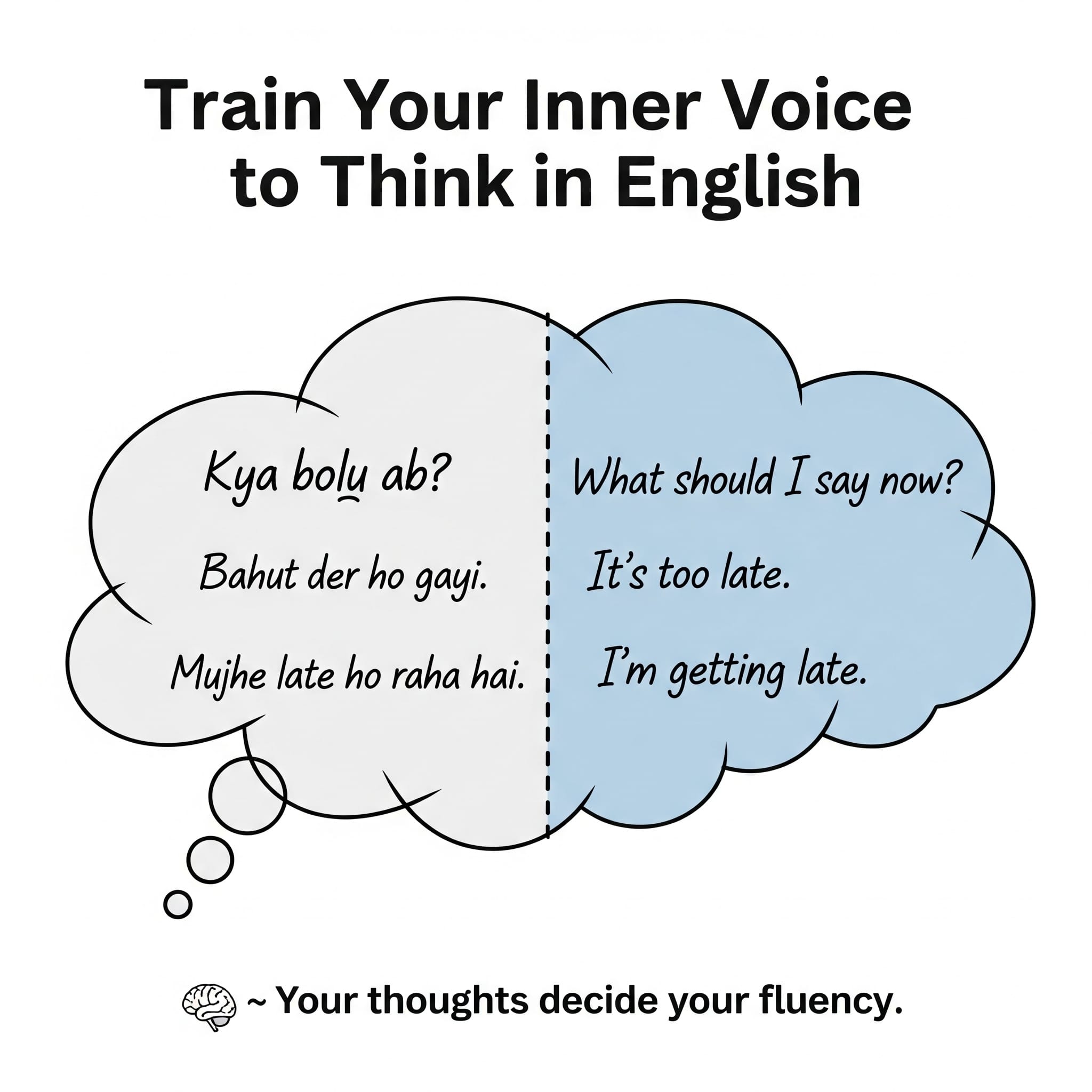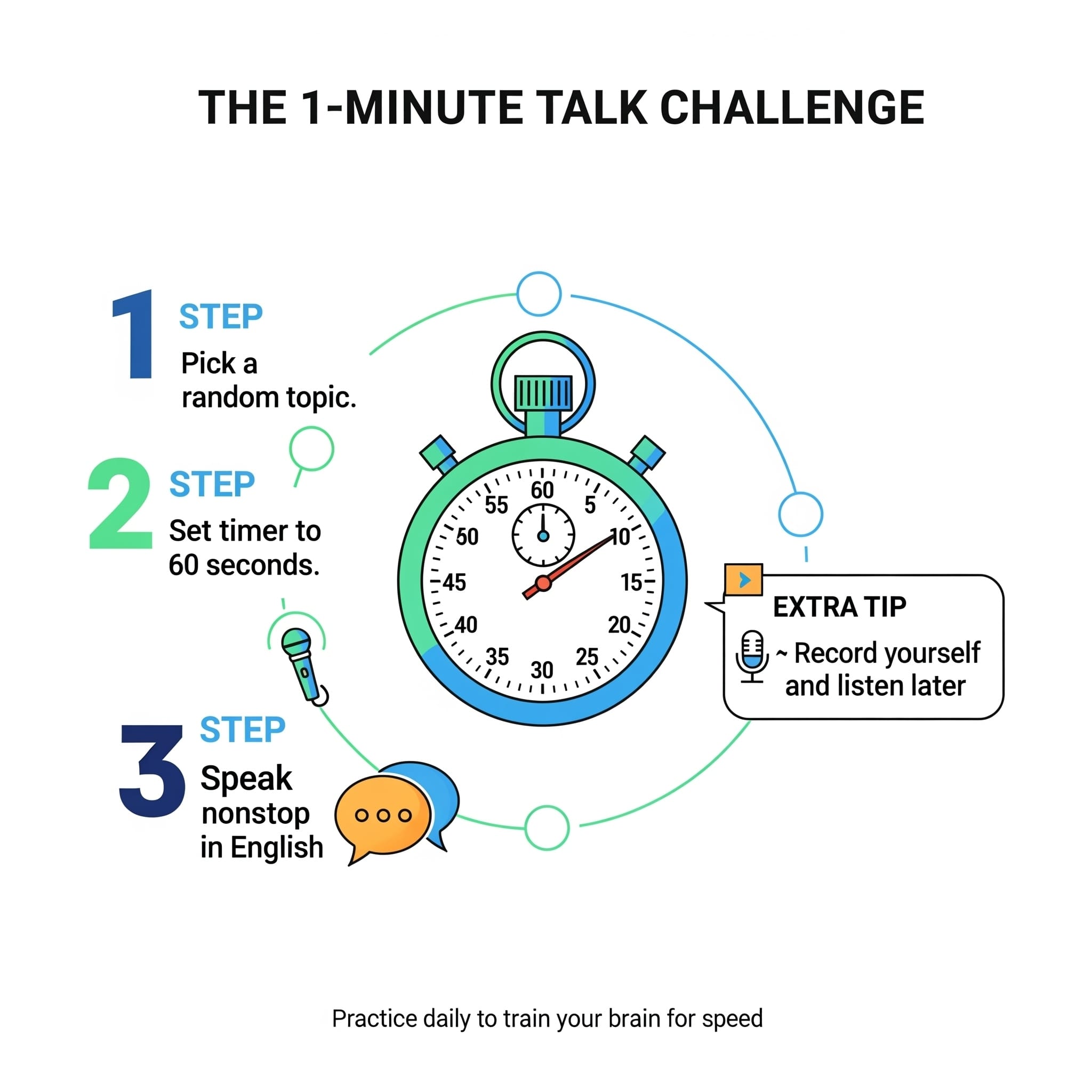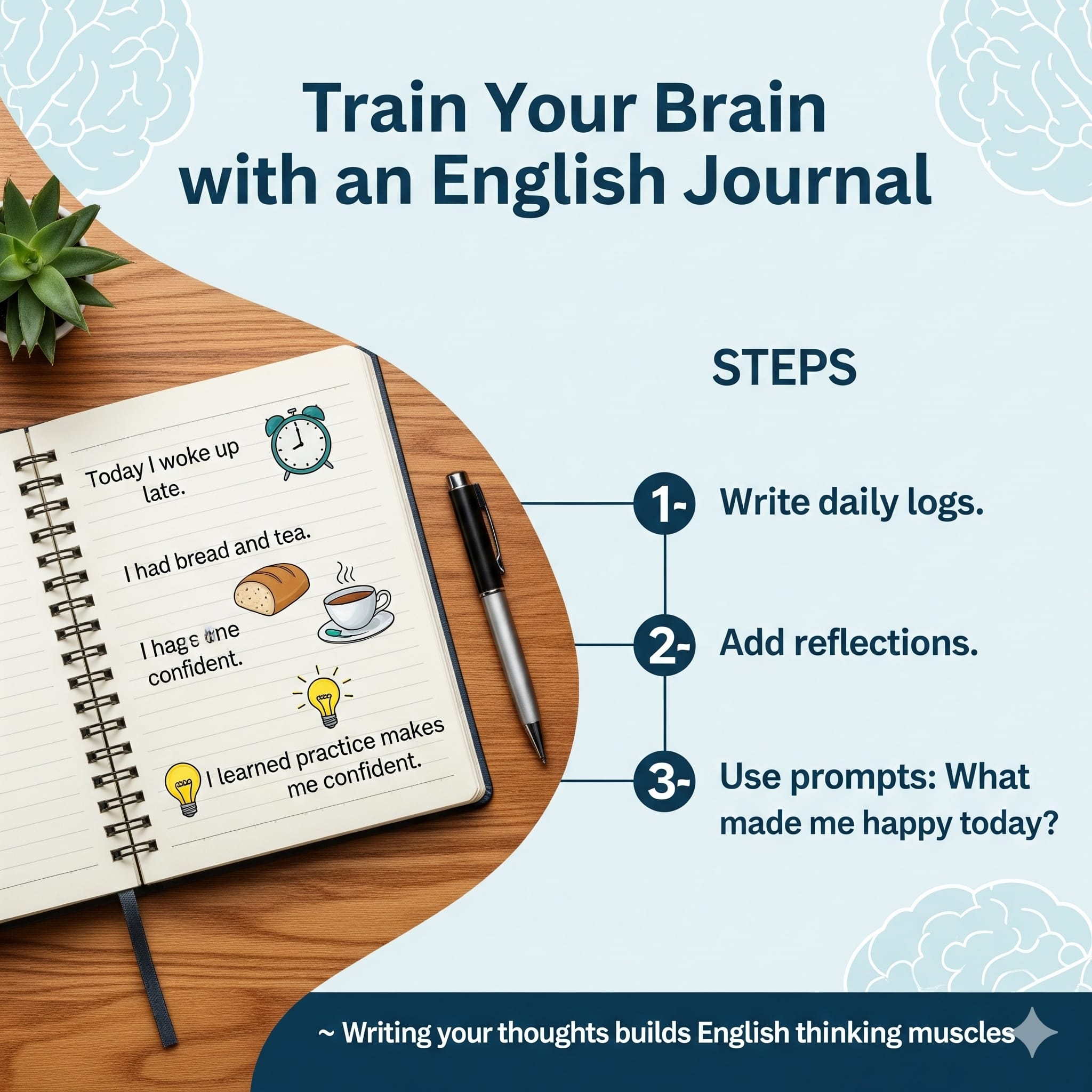How to Think in English (Stop Translating): 15 Practical Mental Fluency Tips
Learn how to think in English without translating. Discover mental fluency tips, practical exercises and Clapingo’s expert guidance to boost your English thinking power.

How to Think in English (Stop Translating)
Have you ever been stuck mid-conversation because you were busy translating in your head? Many English learners face this challenge. You know the words. You know the grammar. But when it comes to speaking, your brain feels one step behind.
The secret is simple but powerful: learn how to think in English.
When you stop translating from your native language, you build speed, clarity, and confidence. This is called mental fluency. In this guide, you’ll learn proven strategies, mental fluency tips, and exercises to train your brain to process English naturally without hesitation.
Why Thinking in English Matters
Thinking in English is not just about fluency. It changes the way you experience the language.
Faster Conversations: No more “buffering” while you search for words.
Sharper Responses: You can answer questions instantly at work or in social settings.
Natural Expression: Sentences flow like they do for native speakers.
Global Confidence: You feel at ease speaking in meetings, interviews, and casual chats.
Simply put: When you think in English, you live in English.
Step 1: Build an English-Only Zone
One of the biggest reasons learners struggle is because their brain is used to defaulting back to their native language. To break this habit, create small “English-only” moments in your day.
- Label items in your house with English names.
- Narrate your actions in English: “I’m making tea. I’m opening the window.”
- Switch your phone and laptop language settings to English.
Clapingo Pro Tip: Start small. Even 15 minutes of thinking in English daily makes a big difference.
Step 2: Train Your Inner Voice
You already talk to yourself in your head. (Don’t worry, we all do!) The trick is to shift that inner voice into English.
- Replace: “Kya bolu ab?” with “What should I say now?”
- Replace: “Mujhe time nahi hai” with “I don’t have time.”
- Replace: “Aaj kya khana hai?” with “What should I eat today?”
At first, it will feel unnatural. But with practice, your brain starts forming direct connections in English.
Step 3: Use Mental Fluency Drills
Here are mental fluency tips that train your brain like a gym workout:
- One-Minute Talk: Pick a random topic (your lunch, your weekend plans) and talk about it in English for 60 seconds without stopping.
- Shadowing: Play an English audio (podcast, movie dialogue, Clapingo expert video). Repeat out loud with the same tone and speed.
- Word Chains: Think of a word, then quickly connect it to another word in English. Example: “coffee → morning → work → office → meeting.”
Did You Know?
Psychologists say that “language switching” slows your brain by almost 200 milliseconds. Thinking directly in English removes that delay.
Step 4: Surround Yourself with English
Language is not only learned, it’s absorbed. Create an environment where English surrounds you.
- Watch English shows with subtitles.
- Follow English-speaking influencers or thought leaders.
- Write daily to-do lists in English.
- Change your playlist: add English podcasts or songs.
The more you immerse, the less your brain depends on translation.

Step 5: Practice Micro-Conversations
You don’t need a big stage to think in English. Micro-conversations train you daily.
- At the cafeteria: “Can you make it a little stronger, please?”
- In office chats: “Let’s circle back on this later.”
- With friends: “Shall we catch up this weekend?”
Even short phrases used often will rewire your brain for English-first thinking.
Clapingo Insight Box
At Clapingo, learners practice real-life conversations with Indian experts. Our sessions are designed to push you to think in English instantly, no time for translation, only natural dialogue.
Try a Clapingo demo today and experience English thinking in action.
Step 6: Journal in English
Writing is a secret tool for thinking. Keep a thought journal but only in English.
- Start with daily entries: “Today I felt tired, but I learned something new.”
- Write about goals, dreams, or frustrations.
- Don’t worry about grammar at first. Focus on clarity of thought.
This habit will train your thought-to-English pipeline.

Step 7: Visualize in English
Instead of words in your native language, attach English words directly to images.
- See an apple → Think “apple” (not “seb” → “apple”).
- Hear rain → Think “rain” (not “baarish” → “rain”).
- Smell coffee → Think “coffee” instantly.
Visualization builds a natural language map in your brain.
Step 8: Use Daily Scenarios as Practice
Thinking in English doesn’t have to be limited to study time. You can use everyday scenarios as practice labs.
Cooking: While chopping vegetables, narrate: “I’m cutting onions. Now I’m boiling water.”
Commuting: On the bus, think: “I might reach late today. The traffic is bad.”
Shopping: Imagine a dialogue: “Do you have this in a bigger size?”
These micro-moments are powerful because they turn your environment into a classroom.
Step 9: Learn Phrases, Not Just Words
One reason learners struggle to think in English is because they focus on individual words instead of ready-to-use chunks.
Examples:
Instead of memorizing “meeting + delay,” learn the phrase: “The meeting got delayed.”
Instead of learning “suggest + idea,” practice: “Can I make a suggestion?”
Instead of “don’t know,” use: “I’m not sure about that.”
When you think in phrases, sentences roll out faster without translation.
Check out our blog: 100+ Daily Use English Words for Fluent Communication
Step 10: Rehearse Conversations in Your Head
Another mental fluency tip is mental rehearsal. Imagine conversations before they happen.
Example:
Before meeting your boss: “I need to update you on the project. Can we schedule a call?”
Before going to a restaurant: “Can I get the menu, please?”
Before calling a friend: “Hey, how’s your day going?”
Rehearsal primes your brain, so when the real moment arrives, English feels natural.
Step 11: Use Technology Wisely
Tech can be your ally when learning to think in English.
📱 Voice Notes: Record daily reflections in English.
🎧 Language Podcasts: Listen while walking or driving.
📺 Subtitles Hack: Watch English shows with English subtitles to reinforce connections.
🤖 Online Platforms: Use additional tools on Clapingo to practice conversations with experts.
Remember: Technology is a support system, not the full solution. You still need real-time practice.
Step 12: Train Your Reactions
Fluency is not only about long sentences, it’s also about quick reactions.
Practice fast, natural responses:
“Really?”
“That’s great!”
“I don’t agree with that.”
“Could you explain that again?”
These short reactions keep conversations alive while giving you time to think of longer answers.
Step 13: Overcome the Fear of Mistakes
One of the biggest barriers to thinking in English is fear. Many learners hesitate because they don’t want to be judged.
But here’s the truth: making mistakes is part of learning. Even native speakers make grammar slips.
How to overcome fear:
Focus on communication, not perfection.
Laugh at small errors; don’t hide from them.
Remember: fluency grows from usage, not silence.
Step 14: Build Mental Associations
Thinking in English becomes faster when your brain connects ideas, not translations.
For example:
Instead of “Garam chai → Hot tea,” just connect the feeling of warmth to the English word “hot.”
Instead of “Udaas → Sad,” connect the facial expression directly with “sad.”
Instead of “Khushi → Happiness,” link the emotion itself to “happiness.”
This technique creates a direct mental dictionary in English.
Step 15: Celebrate Progress (Even Small Wins)
It’s easy to get frustrated, but motivation grows when you notice progress.
Keep a “fluency tracker” where you mark days you practiced.
Celebrate small victories: first time you spoke without translating, first English-only conversation.
Reward yourself, watch a movie, enjoy a treat, or share your progress with a friend.
Progress isn’t always dramatic, but every step counts toward building confidence.
Step 16: Switch Your Digital World to English
Most learners keep their phones, laptops, and apps in their native language. Changing your digital environment forces your brain to process in English.
Change your phone language to English.
Follow English-speaking creators on social media.
Write emails, calendar notes, and reminders in English.
Even Google searches; type them in English.
Your brain will start seeing English as the “default.”
Step 17: Practice “Thinking Aloud”
Sometimes, silent thinking is not enough. Try thinking out loud in English to train both thought and speech together.
Example:
While cooking: “I need salt. Okay, now I’ll add some tomatoes.”
While getting ready: “Should I wear the blue shirt or the black one today?”
This creates a stronger mind–mouth connection.
Step 18: Engage with Micro-Content
Fluency is built on repeated exposure. Instead of watching long lectures, try short, daily bites of English:
1-minute YouTube shorts
Instagram reels with subtitles
Word-of-the-day apps
Mini-dialogues or jokes
Small doses every day are easier to absorb than one big study session.
Step 19: Journal in English (Brain Dump Method)
Journaling helps you transfer your thoughts directly into English.
How to do it:
Spend 5 minutes each morning writing what’s on your mind.
Don’t worry about grammar just focus on expression.
Example: “I woke up late today. I feel lazy but I need to finish work on time.”
Over time, journaling reduces mental translation.
Step 20: Use the “Shadowing Technique”
Shadowing = listening and repeating immediately.
Steps:
Play a short clip (news, podcast, movie scene).
Repeat the sentences at the same time, matching speed and tone.
Don’t pause too much. Flow is more important than accuracy.
This technique sharpens both listening and thinking speed in English.
Step 21: Play “What If” Games
Train your imagination in English. Ask yourself “what if” questions:
“What if I won the lottery?”
“What if I had to move abroad tomorrow?”
“What if my boss asked me to lead a new project?”
Answer them in English. It’s fun and builds creative fluency.
Step 22: Teach Someone in English
Teaching is one of the best ways to master a skill.
Explain a recipe in English to a friend.
Teach your child basic English words.
Record a short explainer video (even if nobody sees it).
When you explain, your brain is forced to think in English first.
Step 23: Surround Yourself with “English Triggers”
Put reminders in your environment to push you toward English thinking.
Examples:
Sticky notes on your desk with phrases: “Stay focused” or “What’s the plan today?”
A calendar with English quotes.
Passwords or WiFi names in English words.
These daily nudges trick your brain into building English-first habits.
Step 24: The 5-Second Rule for Thinking
Whenever you get a thought in your native language, immediately try to rephrase it in English within 5 seconds.
Thought: “Mujhe bhookh lagi hai.”
English: “I’m hungry.”
This trains speed and reduces hesitation.
Step 25: Reward Yourself in English
Turn English learning into something enjoyable.
Watch your favorite movie only in English (no subtitles).
Read a fun book or comic in English.
Join an online community where you can chat in English about your hobbies.
Enjoyment = consistency, and consistency = fluency.
Step 26: Track Your Fluency Growth
You won’t notice progress unless you measure it.
Ideas:
Record a 1-minute English video every week and compare after a month.
Keep a list of “new phrases I used without translating.”
Ask a friend/coach for feedback monthly.
Tracking progress makes you motivated to keep thinking in English.
Tips & Tricks for Faster Results
Use timers: Give yourself 2 minutes to think through a problem in English only.
Don’t over-correct: Thinking speed matters more than grammar perfection at first.
Repeat daily sounds: Everyday phrases like “How are you?” should become automatic.
Find a buddy: Speak with a friend who agrees to only use English with you or connect with an English-speaking expert who can guide you. (Platforms like Clapingo can help you)
The Clapingo Advantage
Why Clapingo Helps You Think in English Faster
Real experts correct your mistakes in real time.
Conversations are personalized to your daily life - workplace, interviews, or casual chats.
You gain the confidence to stop translating and start responding naturally.
Thousands of Indian learners use Clapingo daily to break the translation habit. Book your first session today
Common Mistakes to Avoid
Focusing only on grammar. Thinking fluency comes from ideas, not rules.
Speaking only in class. You need daily self-practice.
Translating idioms word-for-word. (Example: “Meri toh fat gayi” ≠ “My stomach tore!” Instead: “I got scared.”)
Waiting for perfect English. Start with what you know. Progress comes from use, not perfection.
Bonus Section: 5 Quick Mental Fluency Tips
Name objects around you in English before using them.
Ask yourself questions in English like “What do I need to do next?”
Narrate your day silently in English.
Play “English only” games like describing things without naming them.
Think in simple sentences first, complex ones will follow naturally.
Fun Facts
Babies don’t translate when they learn their first language, they associate directly with objects and actions.
Research shows it takes around 600–750 hours of active exposure to become fluent in a new language.
Listening for just 15 minutes daily can significantly boost your English processing speed.

Real-Life Applications of Thinking in English
Fluency is not just theory, it changes your daily life:
At Work: Present ideas confidently, write faster emails, contribute in meetings.
In Social Life: Start conversations without overthinking, connect with friends globally.
In Learning: Absorb movies, books, and courses directly in English.
In Travel: Handle directions, food orders, and interactions without hesitation.
Thinking in English = living in English.
The Science Behind Thinking in English
Many learners don’t realize that translation slows down the brain. Research in psycholinguistics shows:
Translating doubles mental effort (first decode in native language, then re-encode in English).
Thinking directly in English activates faster recall pathways.
Regular exposure and repetition rewire your “mental default” language.
When you train your mind to skip translation, you save cognitive energy and speak more naturally.
Common Myths About Thinking in English
There are many misconceptions that stop learners from progressing:
❌ “I need perfect grammar before I think in English.”
✅ Truth: Fluency comes from practice, not grammar perfection.
❌ “Only people living abroad can think in English.”
✅ Truth: With the internet, English immersion is possible anywhere.
❌ “Translating is faster at first, so I should stick to it.”
✅ Truth: It feels easier at the start, but slows down long-term growth.
Busting these myths helps learners stay motivated.
Bonus: 7-Day Practice Challenge
Day | Daily Task |
Day 1 | Narrate your morning routine in English. |
Day 2 | Write 10 sentences about your day in a journal. |
Day 3 | Watch a 5-minute English video and shadow it. |
Day 4 | Change your phone settings to English. |
Day 5 | Practice a “what if” scenario. |
Day 6 | Record yourself speaking for 2 minutes. |
Day 7 | Join a Clapingo session to practice live. |
Clapingo Section: Why Guided Practice Speeds Fluency
While self-practice helps, structured coaching accelerates thinking in English.
With Clapingo, you:
Get instant feedback on your thoughts and speech.
Practice real-world conversations.
Break translation habits with expert guidance.
Don’t just read about fluency, train your brain to think in English with Clapingo
Learning to think in English is not about memorizing rulesit’s about rewiring your brain for speed and clarity. Start small, practice daily, and surround yourself with English.
With the right strategies and guidance from platforms like Clapingo, you’ll stop translating, start thinking in English, and unlock true fluency.
Comments
Your comment has been submitted successfully!